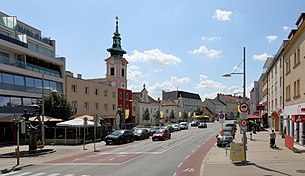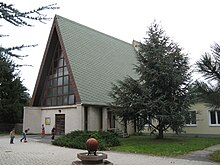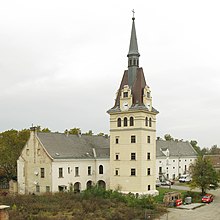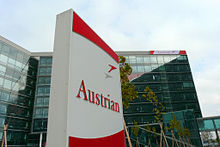Schwechat
|
Borough Schwechat
|
||
|---|---|---|
| coat of arms | Austria map | |
|
|
||
| Basic data | ||
| Country: | Austria | |
| State : | Lower Austria | |
| Political District : | Bruck an der Leitha | |
| License plate : | SW | |
| Surface: | 44.83 km² | |
| Coordinates : | 48 ° 8 ' N , 16 ° 29' E | |
| Height : | 162 m above sea level A. | |
| Residents : | 19,570 (January 1, 2020) | |
| Postal code : | 2320 | |
| Area code : | 01 | |
| Community code : | 3 07 40 | |
| NUTS region | AT127 | |
| UN / LOCODE | AT SHT | |
| Address of the municipal administration: |
Rathausplatz 9 2320 Schwechat |
|
| Website: | ||
| politics | ||
| Mayoress : | Karin Baier ( SPÖ ) | |
|
Municipal Council : ( 2020 ) (37 members) |
||
| Location of Schwechat in the Bruck an der Leitha district | ||
 Schwechat main square (2019) |
||
| Source: Municipal data from Statistics Austria | ||
Schwechat is a municipality with 19,570 inhabitants (as of January 1, 2020) southeast of Vienna , on the Schwechat River . The city is known for the Vienna International Airport , the largest oil refinery in Austria owned by OMV and the Schwechat brewery's “Schwechater Bier” brand . The municipality is located in the Lower Austrian district of Bruck an der Leitha .
geography
Schwechat is located on the northern edge of the Vienna Basin at the confluence of the Schwechat into the Danube. The city has already merged with Vienna in the northwest ; it borders directly on settlement area in the Vienna district of Simmering and on agricultural area in the district of Favoriten .
Map with all coordinates of Schwechat: OSM | WikiMap![]()
City structure
The community consists of four cadastral communities and is divided into four towns of the same name (area in brackets: as of December 31, 2019 or population: as of January 1, 2020):
- Kledering (77.08 ha; 653 Ew.): From the central shunting yard Wien-Kledering dominated village south of the Vienna central cemetery
- Mannswörth (2,521.13 ha; 2093 Ew.): Village near the airport, between the refinery and the Donauauen, through which the Schwechat flows into the Danube
- Rannersdorf (421.67 ha; 3104 Ew.): Village with a suburban character, through which Schwechat and its arm Frauenbach flow, with the confluence of the Liesing in the Schwechat
- Schwechat (1,455.71 ha; 13,720 Ew.): The industrial city on the railways and the motorway
The airport is located in the easternmost part of the city on the border with Fischamend and connects to the alluvial forest of the Danube in the north.
Location in the transport network
On the road, Schwechat can be reached via the A 4 east motorway as well as the B 11 Mödlinger Straße . In addition, the streets Preßburger Straße B 9 and Budapester Straße B 10 lead east and southeast, respectively, which branch off after the main axis Wiener Straße / Hauptplatz / Bruck-Hainburger Straße, which is a continuation of Simmeringer Hauptstraße in Vienna. Since 2006 there has been a direct connection to the Südautobahn and the Wiener Außenringautobahn via the Vienna Outer Ring Expressway S 1 . The most important means of public transport is the S-Bahn line S7 with the stops Schwechat, Mannswörth and the Flughafen Wien train station , there is also a stop for the S-Bahn line S60 in the cadastral community of Kledering, as well as local and regional bus routes.
climate
|
Average monthly temperatures and rainfall for Schwechat
|
|||||||||||||||||||||||||||||||||||||||||||||||||||||||||||||||||||||||||||||||||||||||||||||||||||||||||||||||||||||||||||||||||||||||||||||||||||||||||||||||||||||||||
history

Early history to the Middle Ages
Neolithic and Bronze Age settlement traces, as well as finds of furrow ceramics and measuring beakers of the Wieselburg culture, which were found on the community area, also indicate an early settlement as the S-fibulae (Schwechat-Pallersdorf type) and the cremation grave of the Kosihy-Caka / Makó- Group. In Roman times there was a cavalry fort (Ala Nova) in today's city of Schwechat , from which numerous archaeological finds testify. From around 800 AD, Bavarian and Frankish settlers settled here and mixed with the remaining Slavic and Avar national fragments. Schwechat was first mentioned as a market in 1334 .
Modern times until today
Schwechat developed towards the end of the Middle Ages into a craft and industrial city, which it is still today. The first breweries were founded in Schwechat in the 16th and 17th centuries. In addition to these, some textile companies have also sprung up in the area. The first was built in 1724. Several mills operated by the water power of the Schwechat River were also active at this time .
Franz Anton Dreher acquired the Klein Schwechater brewery on October 22, 1797. But it was only his son, Anton Dreher junior , who made his breakthrough in the brewing industry. He is considered to be the founder of the Schwechat brewery dynasty in the 19th century when, with the help of the managing directors of St. Marx and Simmering, he merged and expanded the companies into an exporting company. This later invented the lager . At around the same time, some mills were being converted into factories.
On August 24, 1922, Schwechat was made a city by a resolution by the Council of Ministers, but on October 15, 1938, the Nazi Reich government incorporated it into the new Greater Vienna as part of the new 23rd district, Schwechat . From 1943 to 1945 there was a satellite camp of the Mauthausen concentration camp in Schwechat , which housed up to 2,600 slave laborers in the armaments industry. In the late phase of the Second World War , the Schwechat industrial plants were often bombed. Reconstruction began in early 1950.
From 1945 to 1955 Schwechat was part of the Soviet zone of occupation (see: Occupied Post-War Austria ). In 1946 the National Council and the provincial parliaments of Vienna and Lower Austria decided to reintegrate Schwechat and many other municipalities into the province of Lower Austria, but this law could not come into force immediately due to the objection of the Soviet occupying power. When this happened eight years late in 1954, Schwechat had already been part of Vienna for 16 years and would have liked to stay that way, but the communities that were to be retired were not given any right of codecision. Thus, on September 1, 1954, Schwechat was again united as a Lower Austrian municipality, administratively with the former municipalities of Alt- and Neukettenhof and the cadastral communities of Kledering, Mannswörth and Rannersdorf to form today's municipality of Schwechat. The first municipal council meeting of the again independent Schwechat took place on the same day. The former political units Albern , Oberlaa , Unterlaa and Rothneusiedl , in the Vienna district of Schwechat since 1938, remained in Vienna.
As a special feature, the Vienna International Airport (VIE) , which is located in the Schwechat area, has its own postcode, which begins with the number 1 used for Viennese postcodes (namely "1300"). The area code for Schwechat telephone numbers is the Vienna area code 01.
In March 2015, the municipal council elected a woman as head of the city for the first time: Karin Baier.
From 1954 until its dissolution on January 1, 2017, Schwechat was part of the Vienna-Umgebung district , but kept the license plate "SW" when moving to the Bruck an der Leitha district .
population
Population development

religion
The Roman Catholic parishes in Schwechat are the St. Jakobus Church on the main square ( Schwechat parish church ) with the subsidiary church Kleinschendung , Mannswörth ( John the Baptist ) and Rannersdorf (Maria-Herz-Kirche). The Protestant Holy Spirit Church on Andreas-Hofer-Platz is subordinate to the Evangelical Superintendent of A. B. Lower Austria . The parish of the Ethiopian Orthodox Church has its seat in Wienerstraße.
Culture and sights


- Railway Museum: is located directly on the Pressburger Bahn
- Ala Nova Castle
- Rothmühle Castle
- Thurnmühle
- Catholic parish church Schwechat
- Evangelical Holy Spirit Church
- Catholic parish church Rannersdorf
theatre
- In the Theater Forum Schwechat , which opened in 1991, guest performances, own theater productions and the Schwechat Satire Festival, which lasts several weeks, take place.
- Since 1973 the Nestroy-Spiele Schwechat , the largest periodic theater event in the city, has been performed every July in Rothmühle Castle in Schwechat-Rannersdorf
Parks
Important urban green spaces are the Rathauspark and the Felmayergarten, a five-hectare landscape garden redesigned in 1997. There is also a fairly extensive green area at Kellerberg, where the Schwechat city forest was started in 2004.
Regular events
Since September 1992 (the city's 70th birthday), the Schwechat city festival has been taking place every year on the main square with live music and concert stages.
Economy and Infrastructure
In terms of purchasing power per inhabitant, Schwechat is one of the wealthiest communities in Austria.
traffic
In addition to its location as a hub in road traffic south-east of Vienna, both the Vienna-Schwechat international airport and the Vienna-Kledering central marshalling yard operated by ÖBB , which is a distribution center for eastern Austria, are of national importance. The city is crossed by the Pressburger Bahn , on which the S-Bahn line S7 runs today in the direction of Vienna-Schwechat Airport and further in the direction of Wolfsthal . Until 1961 the tram line 72 of Wiener Linien ran from Vienna through Simmeringer Hauptstraße to Schwechat. Today there are plans to re-establish it as an extension of Vienna tram line 6. Along the course of the river there are also largely crossing-free cycle paths, for example in the direction of Wien- Oberlaa .
Since April 2006, the S 1 expressway has also passed through Schwechat, which connects the A 4 east autobahn (Schwechat junction) and the A 2 south autobahn (Vösendorf junction). It is one of the most modern roads in Europe (apart from the connection from the A 4 from the east to the S 1).
media
Schwechat has a local TV station with SW1 , which can only be received via cable TV. Terrestrial radio and television stations can mainly be received from the Kahlenberg location .
Public facilities
Judiciary
The District Court of Schwechat is located in Altkettenhof Castle .
Security agency
The State Police Department (LPD) Lower Austria acts as the security authority for the city through its branch office, the Schwechat Police Department. Schwechat is, besides Leoben , the only non- statutory town whose security administration is carried out by the state police headquarters. The city police station Schwechat is attached to the LPD as the station of the guard for the city area . Both offices are also responsible for the parts of Schwechat Airport that are not in the municipality of Schwechat. Since the security administration is not carried out by the district authority, Schwechat has a license plate code that differs from the license plate code of the rest of the district, namely SW .
Due to persistent problems with vandalism, evening noise pollution, as well as problems in playgrounds and in the summer pool, a private security service has been employed since July 2019, which is supposed to increase security in the city through regular patrols. The security service is to work closely with the Schwechat city police, which is overloaded due to a lack of staff in relation to the workload.
rescue
For the rescue services cover places in Schwechat has Austrian Red Cross in Schwechat a location with currently eight ambulances and rescue vehicles , of which about at least the clock for the population in use and which are during the day occupied on weekdays mostly by civil servants and paid staff , during the night and on the weekends as well as on public holidays, only volunteers manned the cars. In addition, there is an ambulance , which is staffed by an emergency physician and volunteer and full-time paramedics. In the event of a disaster, the office also has an air tent with tent heating and an emergency equipment vehicle.
Established businesses
There are around 18,000 jobs in Schwechat. Schwechat's economy is closely linked to Vienna. There are here numerous industries, including in the years 1958 to 1961 built oil refinery of OMV AG in Schwechat. Another important business enterprise is the Schwechater brewery , which today belongs to the Brau Union and which emerged from the Anton Dreher brewery . Other important businesses include: a. the Vonwiller mill , Schwechater cable works AG and Borealis (former Danubia).
Other leading companies include Austrian Airlines , Austro Control and VIE Vienna International Airport / Flughafen Wien AG associated with the aviation location, as well as the sporting goods manufacturer Head Tyrolia Mares and Air Liquide Austria .
tourism
- Kellerberg with cellar taverns : One attraction of Schwechat is the Kellerberg or the cellar tavern , a collection of wine taverns on the eastern edge of the village.
Educational and research institutions
Schwechat is promoting the development of a communal information society and is increasingly promoting the settlement of ICT companies. To this end, the five-year program eSchendung.at (2005–2009) with the main projects Mobile Net Schwechat (urban WLAN ), LivingLab Schwechat (ICT test region ) and the R&D and educational institutions CEIT Central European Institute of Technology and academia nova was launched.
With the CEIT, the Central European Institute of Technology, Schwechat has founded a non-university research and development facility in the field of applied research since 2006 . The start took place in two areas
- CEIT RALTEC (nursing and rehabilitation research, eHomecare, eHealthcare, Ambient Assisted Living )
- CEIT ALANOVA ( Urban Planning , Transport , Environment and Information Society Technologies)
Academia nova GmbH operates the higher technical institute for professionals for information technology and college for professionals for information technology, private school of the city of Schwechat, and since September 2008 has offered dual bachelor courses initially at the (meanwhile insolvent) vocational academy North Hesse , currently (as of 2012) the international one Vocational Academy of the F + U group of companies.
Schwechat has several elementary schools and new middle schools, as well as a federal high school / federal high school .
Sport and freetime
Sports and leisure facilities
- Leisure center: Schwechat has had an extensive outdoor pool since 1960 (47,000 m², 4,000 visitors), which has been an indoor pool since 1976 and an ice rink since 1984.
- Rudolf Tonn Stadium (capacity 7,000 spectators) near Rannersdorf, completed in 1980.
- Cycle paths: The paths along the Liesing and Schwechat rivers with inner-city cycle paths are around 24 km.
- Körnerhalle: Event hall opened in 1960, named after the former Austrian President Theodor Körner - demolished in early 2016.
- Multiversum: Event hall since January 11, 2011 (official opening).
- In 2013, the Multiversum hosted the European table tennis championship for the first time on Austrian soil .
- Disc golf facility in the Mannswörth recreation area - set up by the municipality of Schwechat in May / June 2018, officially opened on July 6, 2018; Planning the course layout; includes (as of April 2019) 7 lanes and 2 practice baskets with putt games. The course has already been used for various TV reports.
Sports clubs (selection)
- SV Schwechat : u. a. Football, handball, athletics, jiu jitsu, artistic gymnastics, bike ball, swimming, volleyball, archery
- SVS Lower Austria : table tennis
politics
mayor
- 1919 to 1930 (1932): Leopold Weinhofer
- 1932 to 1934: Wilhelm Wache
- 1946 to 1947: Alfred Horn
- 1973 to 1991: Rudolf Tonn
- 2002 to 2013: Hannes Fazekas
- until 2015: Gerhard Frauenberger
- since 2015: Karin Baier
Sister cities and city friendships
There is a registered city partnership with the following cities :
-
 Gladbeck , Germany, since December 16, 1966
Gladbeck , Germany, since December 16, 1966 -
 Enfield , England, since December 16, 1966
Enfield , England, since December 16, 1966 -
 Skalica , Slovakia, since September 19, 1992
Skalica , Slovakia, since September 19, 1992
There is also a friendship between the cities of Burghausen , Germany.
![]()
-
 Alanya , Turkey, January 17, 2002 to August 31, 2016
Alanya , Turkey, January 17, 2002 to August 31, 2016
Sons and daughters
- Leopold Bucher (1797–1877), portrait and history painter.
- Anton Dreher senior (1810–1863), brewer, inventor of the Schwechat lager
- Christopher Dibon (* 1990), ÖFB national player
- Joseph von Eybler (1765–1846), composer and court conductor
- Johann Fillunger (1807–1879), technician and statistician
- Rudolf Hausleithner (1840–1918), portrait and genre painter
- Alfred Horn (1898–1959), mayor and honorary citizen of Schwechat
- Viktor Klima (* 1947), Federal Chancellor from 1997 to 2000
- Trude Mally (1928–2009), singer of folk and Viennese songs
- Wilhelm Plankl (1900–1958), classical philologist and translator
- Ines Reiger (* 1961), jazz musician, singer and music teacher
- Walter Scheuer (1927–2012), actor
- Anton Schrödl (1820–1906), lithographer, animal and landscape painter
- Ernst Seidler von Feuchtenegg (1862–1931), lawyer, Imperial and Royal Prime Minister 1917/18
- Paul Senftenberg (* 1967), author and teacher
- Max Stotz (1912–1943), fighter pilot
- Rudolf Tonn (1931–2015), politician
- Karl Trabitsch (1929–2003), politician and businessman
- Anton Träger (1819–1860), cellist and composer
- Rudolf Viertl (1902–1981), football player
- Rudolf Vytlačil (1912–1977), football player
- Wilhelm Wache (1875–1939), politician and mayor
- Leopold Weinhofer (1879–1947), politician and mayor
- Moritz von Wohlgemuth (1805-1852), frigate captain
- Hans Zyla (1919–1999), politician and building clerk
literature
- Christian Fastl: Schwechat. In: Oesterreichisches Musiklexikon . Online edition, Vienna 2002 ff., ISBN 3-7001-3077-5 ; Print edition: Volume 5, Verlag der Österreichischen Akademie der Wissenschaften, Vienna 2006, ISBN 3-7001-3067-8 .
Web links
- 30740 - Schwechat. Community data, Statistics Austria .
- Entry on Schwechat in the database of the state's memory for the history of the state of Lower Austria ( Museum Niederösterreich )
- Official website of Schwechat
- Schwechat. In: Lower Austria 3D. Retrieved on November 5, 2017 (3D representation of selected buildings and monuments).
Individual evidence
- ↑ Regionalinformation , bev.gv.at (1,094 kB); accessed on January 10, 2020.
- ↑ Statistics Austria: Population on January 1st, 2020 by locality (area status on January 1st, 2020) , ( CSV )
- ^ Website of the superintendent .
- ↑ Private Security for Schwechat. In: noen.at. Niederösterreichische Nachrichten, July 22, 2019, accessed on September 12, 2019 .
- ^ Schwechat - Turkish city terminates the partnership. NÖN, accessed on September 1, 2016 .
- ↑ Turkish city Schwechat terminates the partnership. In: oe24.at. September 1, 2016, accessed September 1, 2016 .












